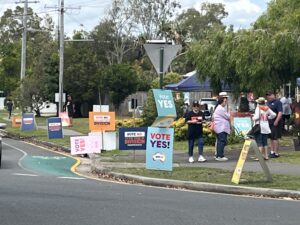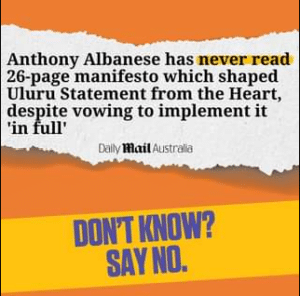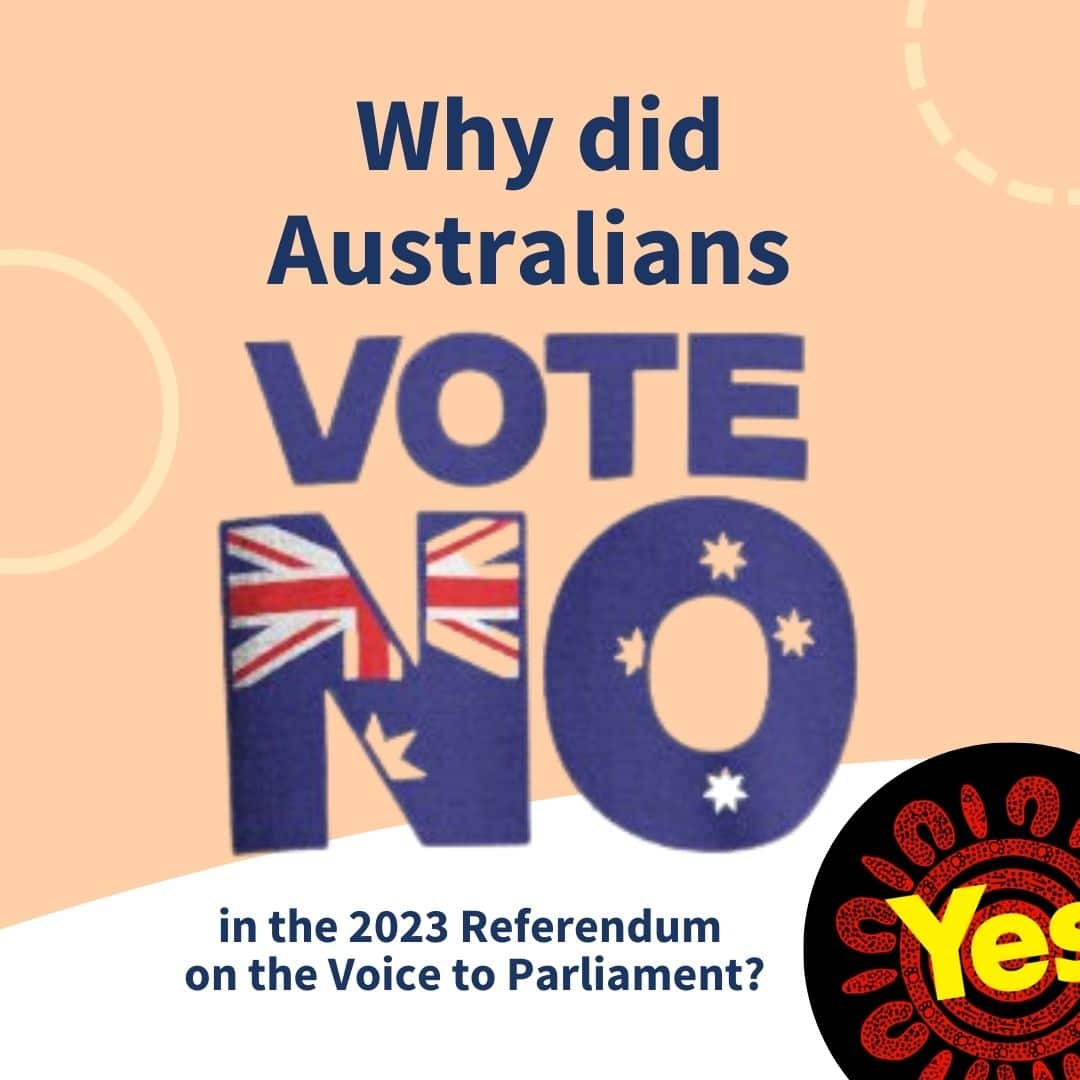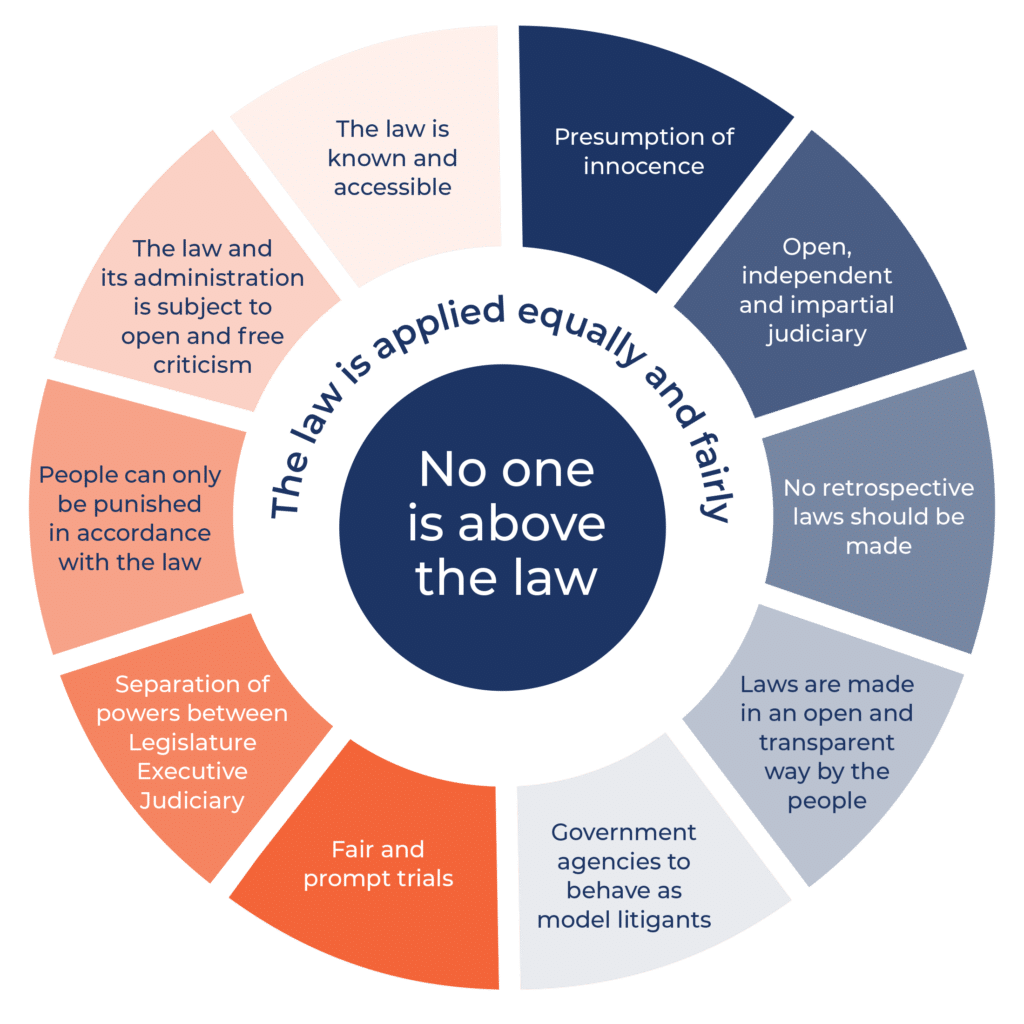Why did Australians Vote No in the Referendum on the Voice to Parliament?
There has been significant discussion as to why Australians voted no to the referendum on the Voice to Parliament. As voters were asked to answer YES or NO, we are not actually given the reasons why people made their decision on referendum day. It could be said that the rejection of the Voice to Parliament in the 2023 Referendum probably has as much to do with the referendum process as it did with the substance of the proposed new entity.
For a referendum to pass it needs community consensus that is usually developed through bipartisan support and political consensus including meaningful discussions and debate at Constitutional Conventions and Parliamentary Inquiries. During the 2023 Referendum, this process did not occur.
Another possible reason why Australians voted against Voice to Parliament for Indigenous Peoples could be that Australians traditionally value a fair go and equal opportunity for all people. Many voters may have believed that the proposed amendment to the Constitution threatened this core Australian value.
Why is the Australian Constitution so hard to Change?
Approval Requires Community Consensus
Section 128 of the Constitution requires amendments to the Constitution only be made if they pass the double-majority test. That is, if they are supported by a majority of the people nationally, and a majority of the people in at least four of the six states.
Changing the Constitution is deliberately a difficult process to protect our foundational ruling document and to ensure;
- the views of the less populous states will not be swamped (which is one of the conditions that persuaded the smaller states to join the federation in 1901); and
- the views of the people will not be swamped by the government of the day (as the Constitution is the people of Australia’s document)
The requirement for a double majority encourages amendments that have broad community support and provides a check on the power of the Federal Government.
Click here to learn more about the Constitution and Referendum Basics.
What does history teach us about successful referendums?
Since federation, there have now been 45 attempts to change the Constitution and just eight have succeeded. The history of the last successful referendum on Indigenous affairs in 1967 might provide some lessons about what might have been done differently.
In the 1967 referendum on Indigenous affairs, 90.8 per cent of the people nationally endorsed a proposal to make two changes to the Constitution. All six states endorsed these changes. In 1967, political consensus was achieved before the issue was put to the people. It was unanimously endorsed by the House of Representatives and the Senate.
Support was so widespread that nobody submitted a case for voting “no” to the Australian Electoral Commission.
Political and community consensus were critical in generating Constitutional change in the 1967 referendum.
Furthermore, one of the key arguments of the 1967 referendum was equality. The “yes” case highlighted the need to remove words from the Constitution that discriminated against Aboriginal people and to provide ‘equal rights for Aborigines.’
Referendum Process failed to generate political and community consensus
The 2023 Referendum process was flawed due to lack of bipartisan support, the failure to hold a Constitutional Convention and an inadequate Parliamentary Inquiry. Community consensus and involvement from such forums may require compromise and open debate but are critical for a referendums to succeed.
i. Lack of Bipartisan support
Prime Minister Anthony Albanese said on the night the referendum failed to pass, “the truth is that no referendum has succeeded without bipartisan support in this country.”
In their analysis of the Referendum, ABC News reporters Kristie Wellauer, Carly Williams and Bridget Brennan stated
“The ABC understands some Aboriginal leaders appointed to the government’s First Nations Referendum Engagement Group were extremely concerned that the government chose to proceed without a compromise on the model, and without bipartisan support.”
This opinion was also supported by YES advocates:
“ Bipartisanship was negated from the very start by Albanese. He did not want it. He excluded the Coalition from all meaningful discussion. This was to be a Labor triumph. Dutton merely trailed in his wake. .. The Indigenous inner circle know all this, because they were part of the decision. They knew exactly what Albanese was doing, and key players just did not care. They stated confidently that the referendum was so obvious it did not need bipartisanship”
– Greg Craven
“In February this year, seven months after Albanese’s Garma announcement and six weeks before the parliamentary committee was finally set up calling the Coalition to the table, I had suggested a way forward to some Coalition members. Liberal Party frontbencher Dan Tehan responded: “We need a process to achieve a bipartisan outcome and nothing is being offered. It is take it or leave it at the moment. It is not clear who we are negotiating with, so who do we put our common ground to? We have stated very clearly we support Indigenous recognition in the Constitution. That should be the starting point. The government won’t even state clearly if the Calma-Langton report is their agreed approach. A detail-lite approach to constitutional change is making it very hard to start consensus building, let alone to reach agreement.”
– Frank Brennan
Bipartisan support would have required some form of compromise of the wording in the proposed referendum question. As outlined by Paul Kelly in his commentary in the Australian newspaper on 18 October,
“the Coalition in office had backed recognition, never the voice… The Coalition parties never had any political ownership of a constitutional voice. … They were spelt out in 2017 by Turnbull and his attorney-general, George Brandis, notably that the Indigenous voice as a “constitutionally enshrined additional representative assembly” was inconsistent with the “fundamental principle” of “equal civic rights” in Australian democracy.”
Compromise and agreement to gain bipartisan support would traditionally have been fleshed out during a Constitutional Convention and proper Parliamentary inquiry.
However …
ii. No Constitutional Convention was held
The general community was denied an opportunity to participate in a genuine constitutional convention.
As outlined by Louise Clegg in the Australian Financial Review in February 2023
“serious constitutional reform has never proceeded on trust or a vibe. From the conventions of the 1890s to the republican convention in 1999, the really important words proposed to be inserted in the Constitution have been pored over, debated up hill and down dale, and thrashed out publicly.”
By not holding a Constitutional Convention to debate the pros and cons of the available models of Constitutional recognition, the Government did not open the proposal up to any form of compromise or parliamentary or community consensus and buy in.
iii. Flawed Parliamentary Inquiry
The parliamentary inquiry into the government’s proposal allowed the community just three weeks to make submissions.
Even with such a short time frame, 270 submissions were made but the Committee recommended no changes be made to the Voice to Parliament proposal.
SBS News reporter Finn McHugh said after the Inquiry:
“The Labor-majority committee, which heard from Indigenous leaders and legal experts over five public hearings, handed down its final report on Friday afternoon, rubber-stamping the government’s suggested referendum question” and noted the dissenting report by Liberal members stating “There is no defensible reason why the government established a committee to consider a permanent change to our country’s constitution with only six weeks to receive submissions, hold public hearings around the country, and report back to the parliament on the legal effect of the constitutional change.” ”
iv. Failure to listen to suggestions for compromise
Aside from Conventions and Parliamentary Inquiries, there were many legal academics and professionals who proposed alterations to the proposed Voice wording and position in the Consitition that would have gained support from the Australian community.
Two examples of these compromises were from Jesuit priest and constitutional lawyer Frank Brennan and barrister Louise Clegg. Click here to learn more.
Our organisation tried many times to encourage the government to make changes to the proposed wording to gain national consensus. In February 2023 we encouraged the Prime Minister to consider a compromise in the final wording of the referedum. Chris Merritt, Vice President of our organisation wrote:
“Recent opinion polling shows support for the Garma provision has been steadily declining since August. Resolve Political Monitor shows support for Garma has slipped from 64 per cent in August to 58 per cent in January. In order to halt that slide, and avoid a tight vote at the referendum, the Prime Minister might find it useful to address the concerns of those like me who favour constitutional recognition of indigenous people but could never support the over-reach that is built into Garma. …
Reforming Garma by adopting the ideas of Brennan and Clegg would inevitably boost the yes vote by reassuring the community that equality of citizenship was safe and parliament had more control.
The overall impact of constitutional change based on the ideas of Brennan and Clegg would be to complete the Constitution, not change it. It would provide a mechanism by which parliament could consult indigenous people before exercising its existing power under section 51(26) of the Constitution to make special laws that affect them – and them alone. ….
A referendum based on the ideas of Brennan and Clegg would eliminate the risk, inherent in Garma, that the voice would conduct itself as a form of shadow government – empowered to develop policies and enter public debates on everything.
An unreformed Garma provision is not worthy of anyone’s support. Brennan and Clegg, however, have handed the government a pathway to national consensus. If their ideas are presented to the nation at the referendum, a yes vote would be justified.”
However, no compromises or changes were made to the wording for the referendum proposal that would have enabled bi-partisan support.
Referendum process suffered due to lack of details
Furthermore, the Referendum process encouraged voters to make a decision based upon the concept of a Voice Parliament rather than providing a detailed model for its implementation. The government did not make public even a broad statutory framework showing how the Voice to Parliament would work and encouraged voters to make a decision based upon the ‘vibe.’
Yes supporters, Gabrielle Appleby and Eddie Synot outlined on the UNSW Newsroom that:
“the Australian people will be asked to vote on at a referendum, not a detailed Voice model. This is also what will be constitutionally entrenched, and unable to be changed (other than by another referendum). Beyond this, there is further debate about what the “model” of the Voice will be.
There is real danger in providing a full, detailed model of the Voice prior to a referendum (for instance, in the form of a draft bill). A complete “model” of the Voice will mislead voters and impair the constitutional function of the referendum. Voters may think they are voting on the detail of the model, and not the actual constitutional provision they are required to vote on.”

The lack of details was believed to be a reason why some Australians voted no, as highlighted by Wellaeur of ABC News who said “many [voters were] confused about what exactly they were voting on and some unaware there was even a referendum.”
Belief in Equality of Citizenship
Australians will vote to “award equal opportunities to individuals regardless of their attributes”, but won’t vote for something that “treats individuals differently.” Waleed Aly quoting pollster Jim Reed in the Sydney Morning Herald on 20 October .
Aly then went on to say:
“From the most prejudiced to the most reasoned and sympathetic, each found cause to baulk at the notion of writing differential rights and representation into the Constitution. Viewed from this angle, the Voice referendum failed for exactly the reason the 1967 referendum succeeded. Both concluded that the Constitution should hand everyone the same basic status.”
Thirty years after the 1967 Referendum change was endorsed, a parliamentary report on constitutional change stated that the intention of the 1967 referendum ”was to remove any ground for the belief that the Constitution discriminated against people of the Aboriginal race”.
Our organisation, as well as many others believed that the Voice may have divided the nation by giving Aborigines and Torres Strait Islanders a constitutional advantage that goes beyond the normal rights of citizenship that are available to others.
This was outlined in our paper, The Argument for Voting No which highlighted that “Constitutional recognition of Indigenous people is desirable and can be achieved. However, this referendum on the Voice is the wrong way to achieve that goal as it creates a Constitutional entity with unlimited scope that erodes a fundamental principle of democracy, the equality of citizenship.”
Conclusion
The Australian Constitution is difficult to change but not impossible. Where there is community and political consensus, grounded in open and transparent debates to ensure our governing document reflects the core values of the whole nation, then a referendum can succeed.
Further Reading
Appelby, G. A and Synot, E. (2022). What do we know about the Voice to Parliament design, and what do we still need to know? Retrieved from https://newsroom.unsw.edu.au/news/general/what-do-we-know-about-voice-parliament-design-and-what-do-we-still-need-know
Aly, W. (2023). Australia turned on the Voice, but it wasn’t because of racism. Retrieved from https://www.smh.com.au/politics/federal/australia-turned-on-the-voice-but-it-wasn-t-because-of-racism-20231019-p5edhh.html
Brennan, F. (2023). Room must be made at the table for other Indigenous voices. Retrieved from https://www.theaustralian.com.au/commentary/indigenous-leaders-statement-a-deadend-car-wreck/news-story/d2e87be68f610dd2acc9290d4830dd05
Clegg, L. (2023). We need a minimalist Voice the whole country can support. Retrieved from https://www.afr.com/politics/federal/we-need-a-minimalist-voice-the-whole-country-can-support-20230207-p5cijp
Commonwealth Parliament of Australia (2023), Inquiry into the ATSI Voice Referendum. Retrieved from https://www.aph.gov.au/Parliamentary_Business/Committees/Joint/Former_Committees/Aboriginal_and_Torres_Strait_Islander_Voice_Referendum/VoiceReferendum/Submissions
Craven, G. (2023). Ingigenous Leaders’ statement a ‘dead-end car wreck’. Retrieved from https://www.theaustralian.com.au/inquirer/room-must-be-made-at-the-table-for-other-indigenous-voices/news-story/fd080462358d922a90e939e06066d5fc
Merritt, C. (2023), Nothing to mourn in rejecting voice of division. Retrieved from https://www.theaustralian.com.au/business/legal-affairs/nothing-to-mourn-in-rejecting-voice-of-division/news-story/7075381aa07a3b3435c6b40ba8fe4c77
McHugh, F. (2023), An inquiry into the Voice proposal has landed. It has just one recommendation. (n.d.). Retrieved from https://www.sbs.com.au/news/article/an-inquiry-into-the-voice-proposal-has-landed-it-has-just-one-recommendation/fcyygvmx9
Kelly, P. (2023), Legacy of the Indigenous Voice to parliament’s crushing defeat will last a generation. Retrieved from https://www.theaustralian.com.au/commentary/legacy-of-voices-defeat-will-last-a-generation/news-story/3fca9032089541015fd0eb763bdc9f67
Wellauer, K., Williams, C., & Brennan, B. (2023). “The Australian community couldn’t comprehend what it was”: Why the Voice failed. Retrieved from https://www.abc.net.au/news/2023-10-16/why-the-voice-failed/102978962
102978962



